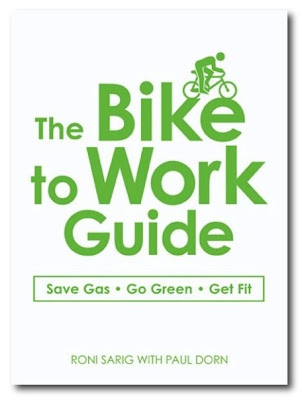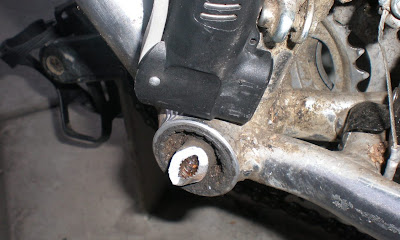 Arriving at the Sacramento Valley Station the other morning to catch my Capitol Corridor train, I saw my friend and fellow multimodal bike commuter Daniel sitting near his crankless bicycle. Upon closer inspection, I noticed this: the spindle on his bottom bracket (where the crank arms attach) had broken on the non drive side. Wow. And I thought I'd seen everything: broken spokes, broken frames, broken derailleur, broken rims, a broken stem (!)...but never a broken bottom bracket.
Arriving at the Sacramento Valley Station the other morning to catch my Capitol Corridor train, I saw my friend and fellow multimodal bike commuter Daniel sitting near his crankless bicycle. Upon closer inspection, I noticed this: the spindle on his bottom bracket (where the crank arms attach) had broken on the non drive side. Wow. And I thought I'd seen everything: broken spokes, broken frames, broken derailleur, broken rims, a broken stem (!)...but never a broken bottom bracket.
Luckily, Daniel was uninjured. Equipment failure is a big cause of bicycle crashes. Most equipment failure can be avoided by frequent maintenance of your bicycle. Daniel confirmed that his bike had been creaking for some time. So he was fortunate. If you hear unusual noises, inspect your bike thoroughly. Remove your cranks and inspect the bottom bracket. Look a the frame, especially the chainstay on the drive side. Examine your chain, fork, brakes.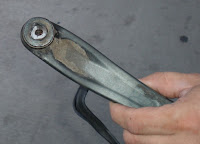
Many cyclists always do the ABC Quick Check before every ride. Check that your tires are properly inflated (A="air"). Check that your brake cables and levers (B="brakes") are fully engaged. Check that your crankset, chain, and cassette are in good working order (C="crankset"). And make sure the quick release on your wheels and seatpost (if applicable) are closed and tight. Doing the "ABC Quick Check" before every ride is a good way to detect possible injurious mechanical failure before it happens.
If you bicycle commute every day, then you will also want to have regular service on your bike. Many routine fixes (replacing chains, tightening spokes) you can do yourself, with the help of online resources or a comprehensive bicycle maintenance book. My new book, The Bike to Work Guide: What You Need to Know to Save Gas, Go Green, Get Fit
, also features a substantial chapter on repairs and maintenance.
If you think you will do most of your own wrenching, my advice is to buy a complete bicycle tool kit. It's much cheaper to acquire a complete kit than to do a one-at-a-time piecemeal acquisition of necessary tools (which is how I built my tool kit.) For major overhauls, don't be too proud to take your bicycle into a shop. I've done everything mechanical on a bike from building wheels to overhauling a bottom bracket (old kind, pre-cartridge), and I'm not ashamed to leave my bike with a skilled mechanic. So take your bike to a shop if necessary. That's why they exist, to provide professional service to keep your bicycle running well.
The reality is that things will eventually wear out on your bike, just as parts wear out on an automobile or a dishwasher. It's not a big deal, as long as you pay attention to your bicycle's condition, and make necessary repairs.
Image: Paul Dorn.
Visit: Broken derailleur messes up New Year's Eve, Bike Commute Tips Blog
Visit: Repairs/Maintenance, Bike Commuting Tips
Visit: Paul Dorn's Bike Commuting Tips Site
Amazon iframe
Thursday, December 04, 2008
Heed those creaking noises
Wednesday, December 03, 2008
Bike commuters laugh at the cold

From the Iowa City Press Citizen, 12.03.08:
Biking is a great way to get around in the summer, but come winter a warm car sounds a lot better than a frosty saddle and bitter winds to many people.Another timely article providing inspiration and information for cold weather bike commuting. Most important lesson offered here: Layer, don't overdress. Missing lesson: Wind protection. Make sure your jacket and pants have some windblock feature. I love fleece, but it doesn't keep you warm on a breezy ride.
But not everyone.
This year it appears more people are forging ahead on their bikes as temperatures dwindle. "I love it," said Ray Haas, 53, who works at University Hospitals. "I really think it's great that more people are being persistent about it."
That's what Haas has been seeing so far, and he would know. The Coralville man has been biking through the winter for the past nine years and says the bike racks are looking full these days. Area bike shops agree that more people seem to be braving the cold this season. Many people picked up the bike commuting habit as gas prices surged earlier this year and are persevering as it turns cold.
Haas bikes to his job year-round. It's an 8.5-mile round-trip commute from home, about 20 minutes. Last winter, he skipped 14 days, he said. "Temperature isn't usually a factor," he said. "On occasion, I am wondering, do I really want to do this today. But once I get going, I feel pretty invigorated, and I don't have regrets. It kick-starts my day. (Read more.)
For an informative and humorous site on cold weather cycling, don't miss Icebike.org.
Image: Web capture.
Visit: Making the most of biking in the cold, Examiner.com
Visit: Bicyclists Try To Stay Safe In Winter Conditions, WCCO.com
Visit: Bundle up for winter riding, Argus Leader (Sioux Falls, SD)
Visit: Winter bike commuting, Minnesota Public Radio
Visit: Decider's guide to winter biking, Decider Milwaukee
Visit: Winter cyclists can enjoy roads less traveled, The Steamboat Pilot (CO)
Visit: Growing number of cyclists commuting in winter, Leader-Telegram (Eau Clair, WI)
Visit: Biking in winter requires forethought, The Coloradan
Visit: Cycling Through the Snow, Detroit News
Visit: Let it snow, let it snow, let it snow, Lawrence Journal World (KS)
Visit: Cold weather no barrier to bicycle commuting, Bike Commute Tips Blog
Visit: Brr: Tips for cold weather cycling, Bike Commute Tips Blog
Visit: Stay flexible during winter cycling, Bike Commute Tips Blog
Visit: Paul Dorn's Bike Commuting Tips Site
Tuesday, December 02, 2008
Bicycles with belt drives excite commuters

From the Seattle Post-Intelligencer, 11.23.08:
Bikes are breaking the chainThe appeal of bicycle commuting should continue to attract new riders in 2009, regardless of the fluctuating trends of gas prices. Among other things--such as new bicycle commuting books--there will likely be a flurry of technical tweaks as the bicycle industry appeals to the novice bicyclist. One very exciting possibility is the belt drive.
Ease of use could help industry's popularity surge
If you've ever been riding down the street and had your pants cuff ripped asunder, there may be a revolution at hand. Trek Bicycle is part of a movement to bury the finger-pinching, pants-munching, rust-prone sprocket and chain, and usher in an era of belt-driven bikes that might have the inventors of the self-propelled transportation Schwinning in their graves.
Wisconsin-based Trek is introducing two models this holiday season that are chainless, instead using technology most often found in things like motorcycles and snowmobiles. While some smaller custom bike makers have used them before, Trek is the first to use the technology for mass-produced bicycles.
"People are really finding bicycles to be a very simple solution to some very complex problems that they face every day," said Eric Bjorling, Trek's lifestyle brand manager. "Anything we can do in our design to really help them and help them live that lifestyle is probably better for both the consumers and us."
Bjorling said the new belts are a low-maintenance solution to a chain, which has roughly 3,000 parts including all the links and connectors. Aside from the whisper-quiet ride, the lighter and longer-lasting carbon-fiber composite belts won't rust, can't be cut, won't stretch or slip and won't leave grease marks around your ankles. A guard over the belt-drive and the construction of the system makes getting your pants stuck unlikely, Bjorling said.(Read more.)
Trek Bicycles is the first major bicycle brand to introduce a chainless, belt driven bike. The chain has been a proven feature of bicycle propulsion for more than 130 years, with some modest issues with lubrication and replacement. Chains aren't going away anytime soon. But the new belt drive is an appealing upgrade. Trek's carbon fiber composite belt is reinforced to prevent stretch, and is supposedly lighter, quieter, and require no lubrication and minimal maintenance.
This belt drive development is another exciting indication that the bicycle industry is starting to wake up to the profit potential of the commuting market. For the past two decades, bicycle makers' R&D efforts targeted the competitive cyclist market, leading to such marvels as 10 speed cassettes and carbon fiber cranksets. Technological advances that offered absolutely nothing to the commuting bicyclist. Maybe the industry is finally starting to come around.
Image: Trek Bicycles.
Visit: TrekDistrict.com Blog
Visit: Say Goodbye To Greasy Chains, Ride A Belt Drive, cbs4denver.com
Visit: Trek belt drive bicycle on CNN, Cyclelicious
Visit: Trek Introducing Belt Drive in January, Bicycle Retailer & Industry News
Visit: Building a better bike, WKOW-TV
Visit: Are Carbon Belt Drives the Future?, BikeRadar.com
Visit: An alternative to the bike chain: The carbon belt, Examiner.com
Visit: Bike retailers warm to the commuting market, Bike Commute Tips Blog
Visit: Bikes made for commuting are hot!, Bike Commute Tips Blog
Visit: Paul Dorn's Bike Commuting Tips Site
Sunday, November 30, 2008
Bicycling and the art of aging actively
From the Sacramento Bee, 11.18.08:
The art of aging activelyI took a two-week break from blogging to travel to the East Coast--including my first visit to the absolutely incredible city of Savannah, Georgia--and to enjoy the Thanksgiving holiday. But I didn't want to miss sharing this inspiring story, the most inspiring since the June article on nonagenarian bicyclist Fred Mathes. There are many physical and mental health benefits of bicycle commuting, including graceful aging. Staying socially engaged and physically active seems to be a winning formula for a long, healthy life. So keep bicycling.
Lucia McLain and daughter Lydia Simonette are examples of how growing older has changed
Let's tell Lucia McLain that she should wear a helmet when she hops on her bike for a spin to Mercy San Juan Medical Center, where she volunteers twice each month.
"I have one," says McLain, who's 93. Of course! And here it is, unused, stored in the bottom of the china cabinet in the living room of her small apartment at the Atrium, a Carmichael assisted- living center. "I use a cap with a shield to keep the sun out," says McLain.
A visor, she means, but that's hardly the point.
"She has done this for 60 years," her daughter, 71-year-old Lydia Simonette, says a bit wearily. Clearly, she's been down this conversational path with her mother a time or two before.
Lucia McLain's old age has been more settled, if still abundantly active. Until July, she lived in her own home, and she mowed the lawn herself. "She had a cherry tree in the yard, and she always climbed a ladder and picked cherries," says her daughter.
"I don't miss the work," McLain says. Even so, she continues biking 10 miles round trip to her Mercy San Juan volunteer duties, sewing Snoopy dolls for ailing youngsters. And she always spends Saturday mornings at Simonette's house, cleaning.
"We've done that every Saturday for 50 years," McLain says.
"And then we'll run errands or go grocery shopping," says Simonette.
Like mother, like daughter: They're too busy to slow down long enough for their age to catch up with them. (Read more.)
Image: Sacramento Bee. Image of 93-year-old bicyclist Lucia McClain.
Visit: Bicycling is a Great Hobby for Senior Citizens, Today's Senior Hobbies
Visit: Bicycling To Better Health, Alive
Visit: Mental Health Alert: Biking Boosts Aging Brains, Cycling For Boomers...Plus
Visit: Nonagenarian rides 56-year-old bike, Bike Commute Tips Blog
Visit: Paul Dorn's Bike Commuting Tips Site
Wednesday, November 26, 2008
Fenders critical for happy bike commuting
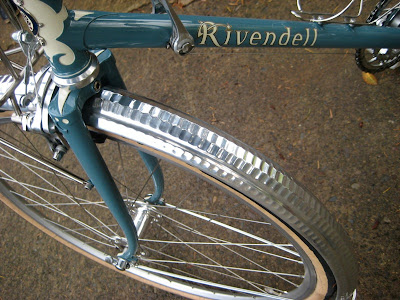
The crack staff at the Bike Commute Tips Blog Research Institute have tabulated the results of our second reader survey on accessories for wet weather bicycling. (The first survey was on motivations for bicycle commuting.) Fenders are the top accessory for happy bicycle commuting in wet weather, according to our very non-scientific poll of readers of this blog.
In response to the question "Most critical accessory for rainy weather commuting by bicycle", fenders drew the highest response, with 43 percent of the votes. I agree with this. Rain falling from the sky is not a big nuisance for bicycle commuters; it's just water. But the oily muck that splashes up from the road is very unpleasant. Bicycling in rainy conditions without fenders results in a dark greasy, muddy stripe up your backside. Fenders are very affordable, easy to install, and can add a classic look to your bicycle. I leave my fenders on all year long. For my hybrid and touring bikes, my favorites include the stylish SKS P35 chromoplastic silver fenders and the effective Planet Bike fenders with mudflaps
.
Following fenders, 34 percent of blog readers felt that a waterproof rain jacket is critical. My favorite rain jacket is the Bellwether Aqua-No Jacket. But for much of my short-distance commuting, a rain cape from REI works fine.
The third most critical accessory for rainy weather bicycle commuting, with 15 percent of votes, is headlights. Visibility is diminished during rain, and motorists are more likely to see you if you're well lit. For most short commuting I manage with an efficient LED from Planet Bike; for darkest conditions I have a Light & Motion Solo Logic. I'm also fond of the Cateye HL-EL410 LED headlight, which attaches easily to any handlebar.
Other important, if not critical, accessories for rainy weather bicycle commuting include rain pants for additional body protection; a bucket of soapy water and a hose for frequent cleaning of the bicycle; and lubrication for moving parts and the chain.
Image: Web capture
Visit: Winter biking 101, Chicago Tribune
Visit: Health, fun top bike commuting poll, Bike Commute Tips Blog
Visit: Paul Dorn's Bike Commuting Tips Site
Thursday, November 13, 2008
More tips for rainy-day bike commuting

From the News-Tribune (Tacoma, WA), 11.06.08:
Experts offer tips to survive riding in the rainMore sage seasonal advice from the savvy bicyclists of the Pacific Northwest.
As Tory Grant slid into some rain gear, the manager of Tacoma's Old Town Bicycle confessed a little secret: It's hard for him to get motivated to go for a bike ride when the weather gets nasty.
He’s not alone. “You know, you hem and you haw for a couple of hours, then you finally do it,” Grant said. “But once you do it, it’s not that bad.” Whether riding for fitness or commuting, the bike doesn’t have to stay in the garage during the cold and rainy seasons. But cyclists who hit the road need to prepare for the outdoor conditions during the fall and winter months.
Here are some tips for winterizing yourself and your ride from local cycling experts...
Lights
On gray winter days, lights aren’t so much for seeing as being seen. Lights ($10 and more) are needed on the handle bars and on the seat stem so you can be seen from ahead and behind, Grant said. And don’t forget to keep your lights charged so they don’t fail you...
Eye protection
(Eye) protection ($20 and more) is a must in the winter to keep rain and road debris out of your eyes. “Some riders even use yellow lenses because they’ll help you see a little clearer,” he said.
Jacket
Grant said a good riding jacket ($40 and more) is the most important item for riding in the wet and cold. Unlike a typical jacket, cycling jackets are longer in the back to, as he said, “keep your butt dry.” Don’t be afraid to pick a jacket with bright colors. Like lights, a colorful jacket is a good way to assure you are spotted by motorists.
Pants
Waterproof pants or riding tights are important for staying warm...
Fenders
Putting fenders ($20 and more) on your bike is a good way to keep you a little drier...
Footwear
Toes go cold fast on a bike, so it seems every cyclist has a trick for keeping their feet warm. Grant wears neoprene booties ($30 and up) over his shoes...
Gloves
Most gloves aren’t waterproof because of all the seams, Grant said, but keeping your hands warm is important.
Add time
(One Tacoma rider) allows extra time for his rides in winter and fall. “Whether it’s riding a heavier bike with fenders or riding in the rain, it adds minutes to my commute,” he said.
Be (extra) alert
Staying alert is always good advice, but it’s especially important in the winter when there are extra hazards. Leaves, road stripes, steel plates and grates are all slippery when wet.
Clean up
Riding in the rain is a good way to shorten the life of your bike chain if you don’t take care of it, Grant said. He suggested lightly rinsing your chain – never use high pressure – then apply a degreaser ($6-$60). (Read more.)
Image: News Tribune (Tacoma).
Visit: Pedalling through the puddles, The Province (Vancouver BC)
Visit: Don't give your bike the cold shoulder this year, Baltimore Sun
Visit: Wet Weather Riding, San Francisco Bicycle Coalition
Visit: Cold weather no barrier to bicycle commuting, Bike Commute Tips Blog
Visit: Brr: Tips for cold-weather cycling, Bike Commute Tips Blog
Visit: Stay flexible during winter cycling, Bike Commute Tips Blog
Visit: Winter cold no obstacle to bicycle commuting, Bike Commute Tips Blog
Visit: Pedaling through winter, Bike Commute Tips Blog
Visit: Paul Dorn's Bike Commuting Tips Site
Wednesday, November 12, 2008
Bicycling continues to gain in Portland

From The Oregonian, 11.12.08:
A banner year for bicycles in PortlandEncouraging editorial in The Oregonian, applauding Portland's continued progress for bicycling. Considered a model by many bicycle advocates, Portland earlier this year received the coveted Platinum level award from the League of American Bicyclists' Bicycle Friendly Community program. The only other Platinum-level Bicycle Friendly Community in the U.S. is Davis, California.
Portland's annual city bicyclist counts posted some impressive numbers for 2008, and fuel prices near $5 a gallon last summer were only part of the explanation.
A report just released by Portland's Office of Transportation shows that bicycle use in the city increased by double digits for the fourth straight year. On top of that, the city's 28 percent increase in overall bicycle use for 2008 was the biggest single-year increase since Portland began counting cyclists at various locations around the city in the early 1990s...
Transportation planners should also be pleased with the year's increase in female bicyclists, an important indicator of success for municipal bicycle programs. In 2008, Portland's proportion of women riders reached an all-time high of 32 percent, up from 26 percent in 1997 and 31 percent in 2007.
High gas prices alone don't account for Portland's accelerating growth in bicycle use. Roger Geller, the city's bicycle coordinator, also credits Portland's modest but steady investments in bicycle infrastructure and encouragement programs, as well as a growing public awareness of the health and environmental benefits of bicycling. (Read more.)
Image: Web capture.
Visit: Is it Green? Portland, Inhabitat
Visit: League honors Portland as top bicycle-friendly community, Portland Business Journal
Visit: Portland: Democracy Now! celebrates bicycling culture, Bike Commute Tips Blog
Visit: Portland's bicycling economy, Bike Commute Tips Blog
Visit: Portland acts to protect cyclists, Bike Commute Tips Blog
Visit: New York Times on Portland bicycling, Bike Commute Tips Blog
Visit: Portland: Leaving the car behind, Bike Commute Tips Blog
Visit: Paul Dorn's Bike Commuting Tips Site
Tuesday, November 11, 2008
Bike sharing sweeps Europe
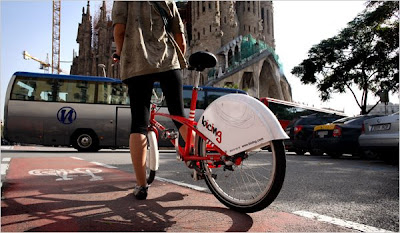
From the New York Times, 11.09.08:
European Support for Bicycles Promotes Sharing of the WheelsInteresting article in the New York Times, suggesting that bike sharing may have a harder time in North America, due to our pervasive car culture, longer commutes, liability concerns, and..."preference for wearing helmets." Programs have been launched in Montreal and Washington DC, with more on the horizon in the U.S. It seems Clear Channel Outdoor is making a significant push with its SmartBike brand.
BARCELONA, Spain — In increasingly green-conscious Europe, there are said to be only two kinds of mayors: those who have a bicycle-sharing program and those who want one.
Over the last several years, the programs have sprung up and taken off in dozens of cities, on a scale no one had thought possible and in places where bicycling had never been popular. The sharing plans include not just Paris’s Vélib’, with its 20,000 bicycles, but also wildly popular programs with thousands of bicycles in major cities like Barcelona and Lyon, France. There are also programs in Pamplona, Spain; Rennes, France; and Düsseldorf, Germany. Even Rome, whose narrow, cobbled streets and chaotic traffic would seem unsuited to pedaling, recently started a small trial program, Roma’n’Bike, which it plans to expand soon.
For mayors looking to ease congestion and prove their environmental bona fides, bike-sharing has provided a simple solution: for the price of a bus, they invest in a fleet of bicycles, avoiding years of construction and approvals required for a subway. For riders, joining means cut-rate transportation and a chance to contribute to the planet’s well-being. The new systems are successful in part because they blanket cities with huge numbers of available bikes, but the real linchpin is technology. Aided by electronic cards and computerized bike stands, riders can pick up and drop off bicycles in seconds at hundreds of locations, their payments deducted from bank accounts.
“As some cities have done it, others are realizing they can do it, too,” said Paul DeMaio, founder of MetroBike, a bicycle transportation consulting company based in Washington, D.C., that tracks programs worldwide. “There is an incredible trajectory.” (Read more.)
Long time bicycle commuters may reap the benefits of these casual bikers, as the presence of riders on public shared bicycles helps swell our numbers, improve our safety, and increase motorist awareness. Gilles Vesco, who runs the Vélo'v bike sharing program in Lyon, told the New York Times: “The critical mass of bikes on the road has pacified traffic. Now, the street belongs to everybody and needs to be better shared. It has become a more convivial public space.”
Image: New York Times.
Visit: Bike Sharing Blog
Visit: Bicing: Barcelona's Communal Bicycle Program Has Transformed The City, Huffington Post
Visit: Bike Share Program For DC NPS Employees Launched, NPS Digest
Visit: Will We Be Able to Pedal Another World Series?, Jewish Exponent
Visit: Bike-Sharing Gets Smart, Bike Commute Tips Blog
Visit: More love for Paris Vélib, Bike Commute Tips Blog
Visit: Paris Velib is chic, trendy, hip, Bike Commute Tips Blog
Visit: Paul Dorn's Bike Commuting Tips Site
Friday, November 07, 2008
Spreading the word on bicycling
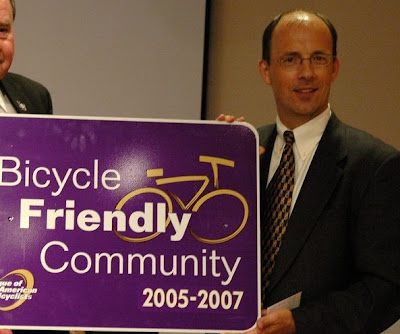
From Lancaster New Era (PA), 11.07.08:
Pedal power: He talks benefits of bicyclesOne of the important functions of advocacy is to proselytize. Spreading the word of the worthy cause. Fresh from the passage of the Bicycle Commuter Act, the League of American Bicyclists continues to press for bicycle-friendly reform. If you aren't a member already, join. We clearly have a favorable tailwind for bicycling. Let's capitalize on this with strong advocacy at the national level.
Andy Clarke made it sound easy. As easy as riding a bicycle.
Clarke, president (sic) of the national League of American Bicyclists, made his case this morning for encouraging bicycle riding in Lancaster County.
Speaking to about 45 county and municipal planners, local police officers and bicycle advocates...Clarke promoted bicycling as a means of improving the overall health of the population, air quality and economic vitality, as well as reducing traffic congestion....Clarke gave examples of what other communities have done to encourage bicycling and receive the League's "Bicycle Friendly" designation.
Workshop planners are hoping the meeting will begin a community dialogue about steps that can be taken here. With relatively minor adjustments, communities across the country have gotten more people riding bicycles. (Clarke) pointed to Corvalis, Ore., where some streets were repainted to add bike lanes. In San Francisco, icons were painted on the roads to indicate where bicyclists should ride. In Carmel, Ind., parallel bike paths were added along some streets.
Portland, Ore., he said, is the shinning example in the United States. City officials there have worked for more than 15 years to expand gradually a bicycling transportation network...Eight percent of Portland's population now uses bicycles as its primary means of transportation. Another 10 percent of residents use bicycles as their secondary means, he said. "They're actually changing behavior," Clarke said. (Read more.)
Image: Web capture. Andy Clarke, League of American Bicyclists.
Visit: Bike Commuter Act part of Fed bailout bill, Bike Commute Tips Blog
Visit: Interview with L.A.B. President Amanda Eichstaedt, Bike Commute Tips Blog
Visit: Advocacy works for bicyclists, Bike Commute Tips Blog
Visit: Paul Dorn's Bike Commuting Tips Site
Thursday, November 06, 2008
Bike shops roll with fuel prices
From the Providence Journal, 11.05.08:
Bike shops roll with fuel pricesInteresting article on the activity at bicycle retailers this year, suggesting repair business accounted for much of the traffic heading into the shops. Whether it's sales or service activity, thriving bike shops reveal a healthy trend. A great bike shop is an indispensable partner for successful bicycle commuting.
When the price of gasoline spiked to $4 per gallon last summer, commuters didn’t rush to bike shops in search of more economical transportation, says Reed Caster, owner of Caster’s Bicycle Center in Warwick.
But many commuters did rush to their garages and basements to spruce up bikes that have been collecting dust for the last five years, says P.J. Ramstack, sales and customer service manager at Civia Cycles, a Minnesota manufacturer of bikes designed for commuting and shopping, as well as for fun. He says independent bike shops saw their service departments prosper when gasoline prices were high.
When they did dust off the bikes, the would-be commuters accessorized them with bags, lights and other gadgets at such a frantic pace, suppliers had difficulty keeping up, according to Eric Lightbody of Todson, Inc...
Caster, Ramstack and Lightbody all attended Interbike Outdoor Demo Days East, a cycling trade show that had its debut in Roger Williams Park last month. Organizers of the event expected more than 1,000 retailers, wholesale distributors and other members of the industry from the East Coast to visit 60 manufacturers of bikes and accessories. Interbike, held annually in Las Vegas, is cycling’s largest trade show in the United States. Outdoor Demo Days gives dealers opportunities to actually try the new products. (Read more.)
Image: Web capture.
Visit: Bike retailers warm to commuting market, Bike Commute Tips Blog
Visit: Bike shop sales strong across the U.S., Bike Commute Tips Blog
Visit: Buying the right commuting bike, Bike Commute Tips Blog
Visit: Bikes made for commuting are hot, Bike Commute Tips Blog
Visit: Massachusetts: Bicycle shops on a roll, Bike Commute Tips Blog
Visit: Paul Dorn's Bike Commuting Tips Site
Saturday, November 01, 2008
Cold weather no barrier to bicycle commuting
From the Salt Lake Tribune, 10.31.08:
Winter biking is no breeze--but it can be doneNorthern California's first significant rain storm came this weekend, soaking Halloween festivities and causing bike commuters to dig out their rain wear and fenders. It's also the end of Daylight Savings Time, meaning more riding in the dark. This welcome article provides a great overview of how to prepare for bicycle commuting in the cold weather months. Many bicycle commuters in colder climates--from Minneapolis to Madison to Montreal to Copenhagen--happily commute year round. With enough preparation, you can too.
We gathered in the back room to confront our deepest fears: Cold. Darkness. Ice. Other people. We couldn't quite wrap our heads around the idea of riding a bicycle to work in the dead of winter. Bike vs. snowplow? The physics of that seemed all wrong. And that kind of thinking is our biggest hurdle, said John Higgins, a year-round bike commuter who...recently gave a seminar on cold-winter commuting..."Think of commuting on your bike as a fun winter sport."
One by one, Higgins struck down potential issues for people who want to extend the bike season, whether because they like the exercise, want to pollute less by leaving the car at home, or need to save on gas money. Here's his advice on every objection we raised.
Fear of commitment: Simply making the decision to ride in the colder months is Job One. "Until you've got that 'Yes, I'm going to' mind-set, the rest is irrelevant," Higgins said. Once you commit, the other problems can be solved. And don't think you have to go all hardcore. Higgins still uses a car in nasty weather, or gets a ride, or uses the busor TRAX. Maybe initially, you'll decide to ride when streets are dry and the temperature is above freezing. A small step is still a step.
Cold: Layering is the key to temperature regulation and wind protection. Many people will already own much of the gear they need - a base layer of wool or synthetic; an insulating layer of fleece; and a lightweight top layer that blocks wind and moisture while allowing heat to escape. Higgins likes zippers on all of the above to allow quicker heat release. You'll have to experiment with different weights to discover what works best for you. Wear a wicking skull cap under your helmet, sunglasses with clear lenses or ski goggles, and five- or split-fingered gloves that allow you to work gears and brakes. Toe covers and shoe covers are helpful if you wear biking shoes; if you don't, any footwear that keeps you warm and dry will do.
Winterizing the bike: If you plan to ride when it's sloppy, fenders are a good idea. Higgins showed clip-on fenders that work on any mountain bike. A more beefy tire might help, too. And you should wipe down the bike every time you ride in the wet, doing a more thorough cleaning every month. Lights are critical - anything you can do to help other people see you is good. I just added a second light on my handlebar, a headlamp on my helmet, and blinking lights on my saddlebags to complement the blinkie on the back. "The more lights the better," Higgins advised.
Choosing a route: In the winter, snow and snowplowing can make some roads impassable. Ice is another issue on spots that don't get sun. So, you'll have to experiment and pay attention to which streets are cleared first. Unfortunately, that's usually the busier ones. Safety is paramount, so there's no shame in ditching the bike when it gets too hairy.
Riding skills: First, slow down. If streets are slippery, brake sooner and more gently. Go easy on the front brake while riding downhill. Snow is similar to sand, which means keeping weight off the front of the bike. (Read more.)
Clothing is really the key. Many bicycle commuting veterans suggest: There's no such thing as bad weather, only bad clothing. As I write on my commuting tips site, the clothing you'll need depends on your climate and traveling distance. For shorter commutes in light precipitation, I manage with a waterproof poncho/cape purchased from REI. For longer rides in rainy conditions, I have a Bellwether Aqua-No jacket and pants, which are waterproof and breathable (allowing perspiration to evaporate.) I also have waterproof gloves and booties. Fenders and rain covers for your panniers (if you don't already have waterproof panniers) are also absolutely essential.
Once your body is protected from the elements, the other major factor for a happy cold weather bike commute is your riding skills. Stopping and turning are more hazardous during wet conditions; be attentive to your speed. As mentioned, prepare for darkness with good lights. For most short commuting I manage with an efficient LED from Planet Bike; for darkest conditions I have a Light & Motion Solo Logic.
What suggestions would you offer a new bicycle commuter for happy cycling in cold weather?
Image: Web capture.
Visit: Cold Riders: Winter doesn't mean an end to bike commutes, Boise Weekly
Visit: Think before biking this winter, South Bend Tribune
Visit: Winter biking? Go for it, Chicago Sun-Times
Visit: Taking that bike out in winter requires planning, Grand Junction Sentinel (CO)
Visit: Wet Weather Riding, San Francisco Bicycle Coalition
Visit: Brr: Tips for cold-weather cycling, Bike Commute Tips Blog
Visit: Stay flexible during winter cycling, Bike Commute Tips Blog
Visit: Winter cold no obstacle to bicycle commuting, Bike Commute Tips Blog
Visit: Pedaling through winter, Bike Commute Tips Blog
Visit: Paul Dorn's Bike Commuting Tips Site
Cycling up 35% in NYC

From the New York City Department of Transportation:
DOT announces 35% increase in commuter cycling from 2007 to 2008It's hard not to be impressed by New York City's great strides to transform and humanize its streetscape, pushed by the effective advocacy of Transportation Alternatives, StreetsBlog, TimesUp!, and many others. In recent years this advocacy has happily met visionary leadership in city government, including from a DOT agency chief hailed as a "cycling radical". Watch the inspiring recent interview with NYC DOT Commissioner Janette Sadik-Khan at StreetFilms and just imagine if your local transportation agency leadership had such vision. Or imagine such leadership in Washington DC.
The New York City Department of Transportation (DOT) (on October 30) announced findings showing that commuter bicycling in New York City has increased an unprecedented 35% between 2007-2008. Cycling levels in the City have doubled during the last six years. With increasing numbers of cyclists on the streets and Daylight Saving Time ending this weekend, DOT will also distribute over 1,500 bicycle lights over the next few days, to help keep New York's ever-growing legion of cyclists more visible. Drivers are reminded to be aware of cyclists and share the road safely with them.
"This unprecedented increase shows we are well on the way toward our goal of doubling the number of bike commuters," said Transportation Commissioner Janette Sadik-Khan. "As these numbers rise, cyclists should take all safety precautions, while drivers must be vigilant when sharing our streets with this growing population."
This growth in cycling follows two years of DOT efforts to rapidly expand and improve New York's bicycle network. DOT added 140 miles of new bicycle routes to the on-street bicycle network in 2007 and 2008. (Read more.)
There are certainly diverse factors contributing to the surge in bicycle commuting in NYC, including fuel prices and economic distress. But clearly infrastructure has made a difference. New York City is reaping significant dividends from its investment in bicycle-friendly infrastructure--bike lanes, bike parking, bicycle access on transit. NYC offers a model to other cities seeking to provide transportation choice, reduce environmental impacts, improve community life, and enhance public health.
Image: Web capture.
Visit: NYC Becomes More Bike-Friendly, The Epoch Times
Visit: NYC Bike Counts Jump 35 Percent, StreetsBlog
Visit: Commuter Cycling Is Soaring, City Says, New York Times
Visit: Commuter cycling soars in NYC, BikeBiz.com
Visit: Streetfilms: A Conversation With Janette Sadik-Khan, StreetsBlog
Visit: Bronx borough president Adolfo Carrión promoting bicycle use, New York Daily News
Visit: Washington Post on NYC cycling, Bike Commute Tips Blog
Visit: More bicyclists in NYC, Bike Commute Tips Blog
Visit: Brooklyn: Bike lanes save lives, Bike Commute Tips Blog
Visit: Paul Dorn's Bike Commuting Tips Site
Thursday, October 23, 2008
Live Free or Drive

Saw this interesting sticker on a bicycle during my morning commute today. The sticker indicated it came from CarFreePortland.org, an organization doing worthy work to fight autodependency. Great sticker.
Of course, another truly great sticker is the increasingly popular ZeroPerGallon decal, as featured on my Bianchi hybrid bicycle. Very timely, and a great way to gently taunt your SUV-driving acquaintances.
Image: Paul Dorn
Visit: It's not just a bike, it's a statement, Bike Commute Tips Blog
Visit: So, like, who's Jim Morrison, Bike Commute Tips Blog
Visit: Removing Bicycle Decals, Instructables
Visit: Paul Dorn's Bike Commuting Tips Site
Tuesday, October 21, 2008
University programs promote bicycling

From the New York Times, 10.19.08:
With Free Bikes, Challenging Car Culture on CampusUniversity students are prime recruits for bicycle commuting: young, relatively fit, cash-poor. (Unfortunately, some insecure college students are also vulnerable to the illusory ego-boosting image of car culture.) As an employee at the most bicycling intensive campus in North America--the University of California, Davis--I've been very happy to see the bike promotion initiatives popping up at university campuses across the U.S. This article from the New York Times provides a great summary.
BIDDEFORD, Me. — When Kylie Galliani started at the University of New England in August, she was given a key to her dorm, a class schedule and something more unusual: a $480 bicycle. “I was like, ‘A free bike, no catch?’ ” Ms. Galliani, 17, a freshman from Fort Bragg, Calif., asked. “It’s really an ideal way to get around the campus.”
University administrators and students nationwide are increasingly feeling that way too. The University of New England and Ripon College in Wisconsin are giving free bikes to freshmen who promise to leave their cars at home. Other colleges are setting up free bike sharing or rental programs, and some universities are partnering with bike shops to offer discounts on purchases.
The goal, college and university officials said, is to ease critical shortages of parking and to change the car culture that clogs campus roadways and erodes the community feel that comes with walking or biking around campus.
“We’re seeing an explosion in bike activity,” said Julian Dautremont-Smith, associate director of the Association for the Advancement of Sustainability in Higher Education, a nonprofit association of colleges and universities. “It seems like every week we hear about a new bike sharing or bike rental program.”
Here at the University of New England, officials wonder what will happen when snow starts falling, but they are looking toward bike-sharing programs in cities like Copenhagen and Montreal as proof that they can work in the cold.(Read more.)
Other higher education initiatives of interest include Michigan State University's bike leasing project; the seven-year-old "cruiser co-op" at the University of Montana; the Ramwheels program at Colorado State University; the used bicycle recycling efforts at Framingham State University; and the bike lending program at the University of Missouri Kansas City.
Other bicycling programs in academia? If you are a university student, faculty, or staff, what is your campus doing to encourage or discourage bicycle use? Any suggestions for encouraging college students to persist with bicycling after they graduate?
Image: University of New England. Bikes are labeled with student names.
Visit: No cars, free bikes for UNE freshmen, Portland Press-Herald
Visit: UC San Diego Campus on Fast Track to Fewer Cars, Newswise
Visit: Bicycle program booming at the University of South Carolina, Island Packet (Hilton Head)
Visit: Cal's Green Bike Share Program, PlayGreen Blog
Visit: Administrators consider instituting project for campus bicycle use, Murray State News (Kentucky)
Visit: SPOKES students put the fun between their legs, The Martlet
Visit: Colleges use rewards to entice students, staff to go green, San Diego Union-Tribune
Visit: Class aims to promote bicycling, The Oxford Press (OH)
Visit: Campus loans out dumped bicycles, Seattle Post-Intelligencer
Visit: On-campus bike use proves helpful for environment, Daily Campus (University of Connecticut)
Visit: Bike co-op makes campus commute quicker, easier, The Hawk (St. Joseph's University, Philadelphia)
Visit: Bikes made fashionable for college, Bikes Commute Tips Blog
Visit: David Takemoto-Weerts: The collegiate cycling environment, Bike Commute Tips Blog
Visit: Colorado study on collegiate helmet use, Bike Commute Tips Blog
Visit: Paul Dorn's Bike Commuting Tips Site
Wall Street Journal: Cycling in London
Interesting report from London, suggesting economic factors and supportive public policy are leading to more bicycling for transportation. According to research cited in this video, the biggest barrier to people traveling by bike is anxiety about "helmet hair" and perspiration. Really? Not safety or secure parking, but coiffure and sweat? Solution might be to ride slow without a helmet, hmmm?
Visit: Is Britain really getting on its bike, Bike Commute Tips Blog
Visit: London announces bicycling encouragement plan, Bike Commute Tips Blog
Visit: Morning bike commute in London, Bike Commute Tips Blog
Visit: Massive rise in London cyclists, Bike Commute Tips Blog
Visit: Paul Dorn's Bike Commuting Tips Site
Thanks to Jack Painter for the story link.
Monday, October 13, 2008
Amtrak's Capitol Corridor adds bicycle capacity
Interesting discovery on my ride home this evening on the Amtrak Capitol Corridor. The car I was on had a new bicycle rack, with space for seven bikes. Six passenger seats had been removed to install the racks.
I use the Capitol Corridor daily, bicycling less than a mile to the Sacramento Valley Station, taking the train 16 miles to Davis, and bicycling 1.5 miles to my office at UC Davis. (Most days I bicycle home, about 17 miles.)
The Capitol Corridor has attracted record ridership the past few months, including more bicyclists squeezing into the existing on-board bicycle storage space. When the three vertical spaces in most standard cars have been full, the conductors have indulged overflow bicycles, a special problem on the commute-hour trains between Sacramento and Davis. This crowding prompted me to buy a Giant Halfway folding bike, in anticipation of eventual Caltrain-style bicyclist bumping when on-board capacity limits are reached.
The Capitol Corridor is an outstanding service for multimodal bike commuters. From the Capitol Corridor website: "Bicycles are welcome aboard Capitol Corridor trains. You can find bicycle racks on the lower level of most coach cars. If all racks are full, notify the conductor. The conductor will identify a place for you to safely secure your bike. Please carry a bungee cord with you, to use in securing your bike."
Many of the bicyclists bringing their bikes on-board the Capitol Corridor might prefer not to. Secure bicycle parking is sadly lacking at most Capitol Corridor stations. BikeStation style bike parking facilities would certainly attract many bicyclists, especially in Sacramento, San Jose, and Oakland.
As gas prices trend higher in the long-term, more multimodal bicycle commuters will be crowding on board transit. It's great to see some innovative thinking to expand capacity.
Images: Paul Dorn
Visit: Have your bike and ride it, too, Mother Earth News
Visit: Loading bike on train requires feat of strength, Arizona Republic
Visit: Bikes crowding onto transit, Bike Commute Tips Blog
Visit: Bikes on Board Amtrak's Capitol Corridor, Bike Commute Tips Blog
Visit: Amtrak Capitol Corridor celebrates 15 years, Bike Commute Tips Blog
Visit: Paul Dorn's Bike Commuting Tips Site
Saturday, October 11, 2008
More press for Bicycle Commuter Act
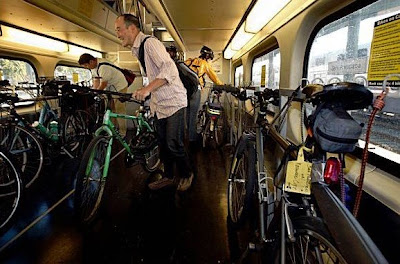
From the San Jose Mercury-News, 10.11.08:
Bailout delivers benefit to bike commutersLast week President Bush signed the rush-job Emergency Economic Stabilization Act, better known as the hasty $700 billion Wall Street bailout. And now the details of this panic measure are being revealed, with the media giving necessary attention to the worthy if modest benefits granted bicycle commuters.
Bicycle commuters across the nation will be eligible for a tax benefit already available to bus and train riders under an 11th-hour addition to the $700 million federal bailout for finance industries
Effective Jan. 1, people who use bicycles as their primary means of getting to work will be eligible to get up to $20 a month in tax-free payments from their employers for the costs of owning and operating a bike. Employers can deduct the payments as an expense from their federal taxes.
Bike enthusiasts in Congress had tried to pass the tax benefit for bicyclists for several years, but were unable to win approval from the Senate until negotiations over the bailout package approved earlier this month.
"What this does is to legitimize commuting by bicycle," said Robert Rayburn, director of the East Bay Bicycle Coalition. "We've already seen a swelling of bicycling commuters on account of the rising gas prices. Until this change in the tax code, bike commuters have been denied a benefit that public transit riders get." (Read more.)
The act changes the tax-code, effective in January, allowing companies to give up to $20 a month to workers who pedal to work, which the employees could use for tires, lights, helmets, locker rental fees, or shower access at a gym. It would be tax-free to cycling commuters, and a tax write-off for employers.
"It's sort of an equity thing," Andy Clarke, executive director of the League of American Bicyclists, told the Arizona Republic. "People who take transit and park their cars already get tax breaks."
Expressing a sentiment felt by many bicycle commuters, Walt Seifert, executive director of Sacramento Area Bicycle Advocates, told the Sacramento Bee: "It's about time. I hope employers jump on the chance to offer it." Jonathan Maus, editor of BikePortland.org, told the New York Times: "It’s a pretty small victory. But this gives a lot of people around the country the ability to walk into their human resources office or their manager’s office and ask for the credit. It helps move the conversation forward."
The media coverage is welcome, because as Maus indicates, the measure only provides an opportunity for an employer tax benefit. It is still up to employers to implement the subsidy, and bicycle commuting employees to demand it. Raising awareness of the measure's benefits to bicycle commuters is critical. As gas prices continue to increase, a $20 monthly incentive is an appealing additional inducement to potential bicycle commuters.
Beyond expensive gas, Americans will be further pinched in future years by collapsing home values, a weaker dollar, diminished retirement accounts, and anxiety about employment. Saving money on transportation will become a big imperative in many households, meaning bicycle commuting will only be more attractive.
Instead of bailing out greedy, irresponsible, and reckless bankers, I wish the Feds had invested in job-creating public works projects, such as transit, pedestrian, and bicycling infrastructure. More bicycle commuters will only mean increased crowding at bike racks and lockers, on the bike trails, on trains and buses. We need more public investment in sustainable transportation. Now.
Image: Web capture.
Visit: Bicycle Commuter Tax Provision: Frequently Asked Questions, League of American Bicyclists
Visit: Bailout bill has biking benefit, Columbus Dispatch
Visit: Buried in the Bailout: The Bicycle Commuter Act, New York Times
Visit: Bailout gives tax break to bicycle commuters, San Francisco Chronicle
Visit: Bailout has a boost for bike commuters, Sacramento Bee
Visit: Bicyclists will benefit from $700 billion bailout, Arizona Republic
Visit: Reimbursement for Bike Commuters Included in Bailout Bill, SustainableBusiness.com
Visit: Tax benefits for commuter cyclists, Austin360.com
Visit: Bicycle Commuter Tax Break Is a Bittersweet Victory for Measure’s Sponsor, New York Times
Visit Employers, Workers Could Benefit From New Program, WISC-TV (Madison, WI)
Visit: Paul Dorn's Bike Commuting Tips Site
Thursday, October 09, 2008
Bicycle travel, with children too!

From the Oregonian, 10.09.08:
Have kids? How you can still travel via bikeMany would-be bicycle commuters have the challenge of needing to transport kids; and many bicycle commuters are children on their way to school. This article from Portland offers a great overview of bicycle travel options with children, considering options such as tandems, trail-a-bikes or tag-alongs, trailers, bicycle seats, long-frame utility bicycles, and the fun-to-ride Bakfiet. No matter how old your child is, there is a way to bicycle commute with kids.
It's no secret that Portland has a love affair with bicycles, but what to do when your kids are too young to ride on their own? With all the fun and functional new biking systems on the market, becoming a parent doesn't mean you have to let your bicycle grow cobwebs. There's a rig for every family, from the simple and relatively inexpensive baby seat to the snazzy Bakfiet, a Dutch cargo bike made for serious hauling.
Best choices for babies and toddlers are attachable seats, trailers or the cargo bike. At age 4 or 5, children may be ready to try a tag-along, family tandem or an Xtracycle. While there's no hard and fast rule for when to switch kids to a more independent riding system, Martina Fahrner, co-owner of CleverCycles in Southeast Portland, offers some advice. "You really need to use your parent instinct," she says. "You know your child's development and what they're comfortable with." (Read more.)
This is the kind of story we can only hope to see more of in the major media, with practical "how-to" information on bicycling for transportation. Americans are likely to be relatively poorer in the next few years. Gas prices are unlikely to go down, especially with an increasingly weaker dollar. The new Bicycle Commuter Act passed by Congress offers a possible cash inducement to bicyclists. Together, these factors among others mean more people will be looking very seriously at the bicycle as a means of transportation in future months. They'll be grateful for helpful articles such as this one.
Image: The Oregonian.
Visit: Twelve tips for bicycling with children, Marion Star (OH)
Visit: Kids and biking, San Francisco Chronicle
Visit: Car-Free Families Blog, BikePortland.org
Visit: Fitness: Safe bicycling for children starts at home, News Press (Ft. Myers, FL)
Visit: Auto traders: Families who give up their cars like the savings--and their life in the slow lane, Boston Globe
Visit: Bicycling With Children: A Complete How-To Guide
Visit: Bicycling with Children, Blue Island Bicycle Club
Visit: The biking parent: Interview with Jon Winston, Bike Commute Tips Blog
Visit: Paul Dorn's Bike Commuting Tips Site
Tuesday, October 07, 2008
Folding bikes for crowded transit
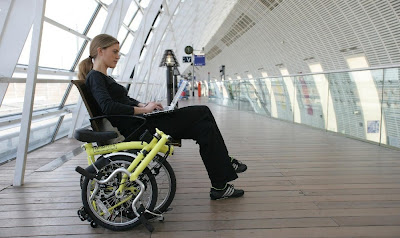
From the Argus (Fremont, CA), 10.06.08:
Folding bikes: a transit alternativeGreat article on the appeal of folding bicycles for multimodal commuting. According to this article, folding bicycles account for less than 1 percent of the 18 million bicycles sold each year in the U.S. However, the market is growing in response to higher gas prices and increased interest in urban living.
IT'S NOT JUST the money she saves on gas that makes her folding bike appealing to Ellen Babcock on her BART ride to work in Oakland. "I like it because it packs up into a little package. I like it because I can ride on BART any time," said Babcock, who rides her bike to a San Francisco BART station. After getting off at the Rockridge station, Babcock pedals to her job of teaching sculpture at the Oakland campus of the California College of the Arts. "It's just so much more pleasant than being in a car," she said.
Taking a folding bike on BART does invite curious inquiries from fellow passengers, she said. That's no surprise given their unique look. Their smaller wheels and high seat and handlebars set them apart from regular, full-sized bikes. While regular bikes have wheels with a diameter of 26 inches, most folding bikes have 16- to 20-inch wheels.
"Folding bikes are not the most chic thing. They are more practical," said BART spokesman Linton Johnson. "They are very good for commuters who want to save on gas and are just going from Point A to Point B. We are seeing a lot more people turning to bikes to save on a gallon of gas, and folding bikes are the way to go." (Read more.)
Crowding aboard transit in my region led me to acquire a great Giant Halfway folding bicycle earlier this year. It's a very handy bicycle, easily toted into the office, tossed in vehicle trunk, or brought on a bus.
Image: Web capture.
Visit: Know when to fold 'em, Boston Globe
Visit: The Best of the Best: Folding Bikes, ecogeek
Visit: Downtube Folding Bicycles
Visit: The Folding Bike Solution, Transportation Alternatives
Visit: Paul Dorn's Bike Commuting Tips Site
Sunday, October 05, 2008
Bike Commuter Act part of Fed bailout bill
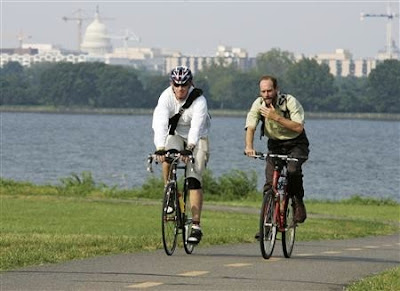
From Bicycle Retailer & Industry News, 10.02.08:
Congress Passes Commuter ActA number of blogs have already commented on the inclusion of the Bicycle Commuter Act into the ridiculous $700 billion Federal pork barrel bailout of Wall Street, including great coverage by Cyclelicious, BikePortland.org, StreetsBlog, and a survey of bicycle commuting attitudes by Outside Online. The bicycle commuter provisions of the bailout have also aroused hostility in less supportive quarters, summarized by Philadelphia Bicycle News:
WASHINGTON, DC (BRAIN)—Employers of people who bike to work stand to gain a $20 per month tax credit per cycling employee, according to the final version of the Wall Street bailout bill, H.R. 1424, passed this afternoon...
What does bicycle commuting have to do with credit issues or covering the debt racked up on Wall Street? Bicycle commuting advocate Earl Blumenauer, a Democratic Representative from Oregon, was one of the 228 Representatives who voted against the House version of the bailout package on Monday. House members looking to pass a bailout bill needed to convince as least 12 of the dissenters to switch their position and vote for a bailout bill...
Congressman Blumenauer spearheaded a seven-year campaign to extend commuter tax benefits to those who bike to work. Andy Clarke, president of the League of American Bicyclists, said the Bicycle Commuter Act has been held up getting through with previous bills. “It’s been attached to a variety of different bills or devices—climate change, energy, transportation,” Clarke said. “It’s ironic that it would wind up in a financial rescue package, but we’ll take it. I’m not going to quibble with the method; I’m glad to see it done.” (Read more.)
"Bicycles are in the headlines today, but not in a good way. (The) Bicycle Commuter Act is tied into the Tax Bailout Bill lumping bicycle commuters with Rum Makers and tax breaks for NASCAR. They are labeling the Bicycle Commuter Tax Break as Pork, does this mean that Transit Check and commuter parking benefits are also Pork?"As I understand it, the Bicycle Commuter Act provides employers a tax break of up to $20 a month if they give some bicycle commuting benefits to their employees. It's a modest step forward. "It may not be a total game changer," the LAB's Clarke told Bicycle Retailer & Industry News. "It's still a relatively small break. But it gets us closer to the kind of treatment that cyclists in the U.K. and other parts of the world have had for years."
This measure may attract a few additional bicycle commuters. Personally, I would have preferred that $700 billion spent on beneficial economy stimulating public works projects, such as passenger rail, bicycle facilities, and transit. However, this bailout will likely have another more significant favorable effect. Essentially, the Fed policy seems to be dollar devaluation, reducing the debt crisis through inflation. This can only mean even higher prices for gas, increasing the relative appeal of bicycle commuting.
Image: Web capture.
Visit: Congressional Bike Caucus
Visit: Bailout Bill Gives Bicyclists a Tax Break, Wired.com
Visit: Bicycle Bailed Out, New Haven Independent
Visit: Bailout passes with Bicycle Commuter Act attached; Bush signs it, BikingBis.com
Visit: Bicycle Commuter Act Becomes Law, Los Alamos Bikes
Visit: Adventures of the Bike Commuter Act, Discovering Urbanism
Visit: Paul Dorn's Bike Commuting Tips Site
